|
The 2005 Counter-Inaugural Protests
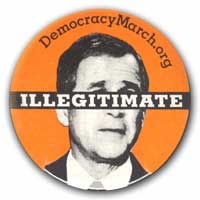
Browse
photos
of the January 20, 2005 Inauguration protests.
After George W. Bush won the 2004 presidential election it was a foregone conclusion that thousands would descend on Washington D.C. on January 20, 2005 to protest his second inauguration. An estimated 20,000 people had demonstrated at his first inauguration -- before his policies and practices had angered so many people.
The second inaugural drew an estimated 25,000 protestors to a wide variety of marches, rallies, die-ins, concerts and other events all over the capitol the week of January 20. Like the first inaugural, the protests were largely peaceful, resulting in only 14 arrests. To insure a predictable outcome, training in non-violent direct action, marshaling, legal rights, and media relations were conducted by local organizations for weeks beforehand.
In anticipation, 70 law enforcement agencies from all over the country sent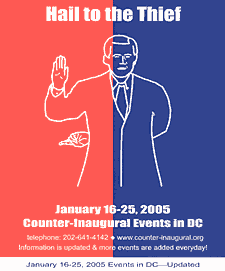 13,000 officers to provide security. Roughly 100 blocks of downtown D.C. from Capitol Hill to the White House were cordoned off with ten foot high steel mesh security fences punctuated by white security tents, in which those watching the official ceremonies or the parade were searched. Even parade-goers who arrived as early as 9:00 a.m. complained that they had to wait in line for two hours before finding a place in the bleachers, which required tickets, or standing room, which did not. At the security tents apples and oranges were confiscated as potential projectiles, but once inside the security zone, there was still plenty of snow from which to make snowballs. 13,000 officers to provide security. Roughly 100 blocks of downtown D.C. from Capitol Hill to the White House were cordoned off with ten foot high steel mesh security fences punctuated by white security tents, in which those watching the official ceremonies or the parade were searched. Even parade-goers who arrived as early as 9:00 a.m. complained that they had to wait in line for two hours before finding a place in the bleachers, which required tickets, or standing room, which did not. At the security tents apples and oranges were confiscated as potential projectiles, but once inside the security zone, there was still plenty of snow from which to make snowballs.
Although the bleachers were 80 percent empty, guards wearing white Security vests kept out those who had not paid for the privilege of a seat. The standees packed themselves behind a double row of waste high metal barriers, three feet apart, which lined both sides of the parade route. Police officers stood shoulder to shoulder on the street side of the barriers, facing the crowd, looking for trouble-makers. Sharpshooters observed the crowd from atop the buildings on the parade route.
The D.C. Anti-War Network (DAWN) took the lead in getting permits and organizing demonstrations, but several different groups did their own thing.
The biggest single event was a Thursday morning rally in Malcolm X Park followed by a 10,000 person march down 16th St. around noon to a closing rally in McPherson Square. The DAWN march was endorsed by United for Peace and Justice , which had organized the massive march in New York before the Republican Convention on August 29, 2004.
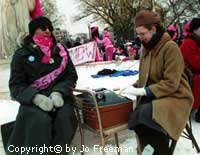 CodePink, which organized its own anti-war march two years ago, held a separate rally of 500 -- mostly women -- in DuPont Circle. There the Ladies of Liberty sang and the Keys of Resistence typed letters to Members of Congress on old-fashioned portable manual typewriters. This was followed by a funeral procession down Connecticut Ave which arrived at the Square half an hour before the DAWN march and then dispersed. Only the Raging Grannies were left to greet the marchers from Malcolm X Park.
CodePink, which organized its own anti-war march two years ago, held a separate rally of 500 -- mostly women -- in DuPont Circle. There the Ladies of Liberty sang and the Keys of Resistence typed letters to Members of Congress on old-fashioned portable manual typewriters. This was followed by a funeral procession down Connecticut Ave which arrived at the Square half an hour before the DAWN march and then dispersed. Only the Raging Grannies were left to greet the marchers from Malcolm X Park.
While most were marching, other groups were doing their own thing. ReDefeat Bush held a small but spirited rally at McPherson Square during the morning. Critical Mass sent 50 bicyclists from Union Station through the DC streets, followed by police watching to see what they did. At least 16 Billionaires for Bush auctioned off Social Security and the Arctic National Wildlife Refuge at the FDR memorial The former went for $61 million to Halliburton; Boeing won the bidding for the latter for $100.
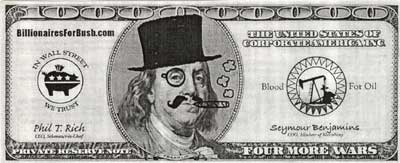
A.N.S.W.E.R. applied for and received from the National Park Service space along the parade route for up to 10,000 people including a section of the official bleachers at the strategic location of 4th and Pennsylvania Ave. A.N.S.W.E.R. set up its own stage and sound system, where several thousand supporters listened to a series of speakers while waiting in the cold for Bush's car to pass. Its prime time space was the result of a 1997 US District Court decision in a case brought by the Christian Defense Coalition which wanted to line the parade route of President Clinton's second inauguration with signs protesting his veto of the Partial Birth Abortion Act. That court had ruled that protestors could not be completely excluded from the parade route. In 2001, the National Park Service set aside areas of the parade route for different protest groups, but insisted that everyone first go through security checkpoints. The US District Court ruled that the delay this would cause was not a violation of the First Amendment. Not satisfied with the 215 feet given them along the 2005 inaugural parade route, A.N.S.W.E.R. lawyers asked for more, but were turned down by the District Court as asking too late.
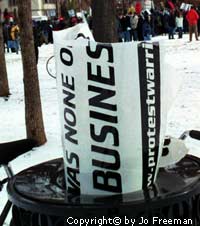
Counter protestors tried their usual tactic of infiltrating the permitted actions in hopes of provoking a reaction. Several Protest Warriors brought their signs to Malcolm X Park, where they were surrounded by anarchists and ushered out, their signs littering the ground in their wake.
They regrouped at 6th and Pennsylvania, in a permitted space reserved for them by Free Republic.
A smaller group followed the DAWN march but stopped at Lafayette Park, where the security fence allowed only ticket holders inside to the main parade viewing stands across from the White House. Intending to be arrested, 17 people lay on the streets in a "die-in." Police declined to play their part and left them lying on the cold asphalt for three and a half hours, until the protestors decided to leave on their own. While they lay there, Republican ticket holders had to walk around them to get to the security check point.
Not everyone marched. Several protestors obtained tickets to standing-room sections in the inaugural area on the West Lawn of the Capitol.
Once they were through the security tents, they pulled signs out from under their clothing and walked around arguing with Republicans. Six Code Pink activists were removed by police for shouting slogans during the inaugural ceremony.
"Turn Your Back on Bush" was the most highly publicized protest and the easiest to participate in. All that was required was getting to the inaugural area or the parade route early enough to go through the long security checkpoints and stand in the public access areas for four or five hours until Bush's motorcade passed by. At that point protestors turned their backs and faced the other way; some held up signs with "liar" and other sentiments on them. No count was made of those who turned their back on Bush, but estimates ranged up to 5,000.
All activists who requested permits got them but several groups chose to keep their plans to themselves and some actions were spontaneous. The Anarchist Resistance broke away from the DAWN march about mid way and veered over to Logan Circle, where they were joined by several hundred others. Chanting and shouting, they marched to 7th and D Streets, where they clashed with police for several minutes. Using pepper spray and batons, the police kept them from getting closer to the parade route.
After the DAWN march reached McPherson Square, the International Socialist Organization asked marchers to join them in continuing on to Pennsylvania Ave. Over a thousand people, mostly younger than those in the main march, filtered through police barricades — cops, cars and jersey barriers — as they walked down 14th St. At Pennsylvania Ave. they were stopped by a steel mesh fence opening into a white security tent.
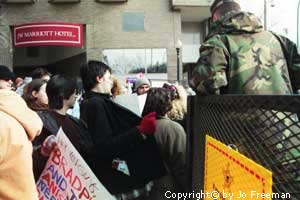
Initially the security gate was shut, but the two soldiers inside quickly decided to open the gate and let the demonstrators in, one at a time. "No backpacks" the soldiers said. "Open your coats."
One by one, the demonstrators did as they were told; only those with backpacks were refused admission. Signs were allowed in, but not the cardboard sticks they were attached to. Once inside, the search was perfunctory as the protestors went quickly through the security tent.
Two to three hundred protestors entered Freedom Plaza this way, though they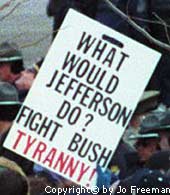 didn't come close to filling the available space. After they worked their way to the standing room areas they waited quietly for the President's entourage. Some carried cardboard signs which they occasionally held above their heads; some wrapped themselves in cloth signs to ward off the cold; some had painted their sentiments on their faces. Most had no signs at all and just blended into the crowd, waiting until the President passed to express their views verbally. A few got into arguments with the Bush fans also waiting in the cold, but mostly they just waited and tried to keep warm. didn't come close to filling the available space. After they worked their way to the standing room areas they waited quietly for the President's entourage. Some carried cardboard signs which they occasionally held above their heads; some wrapped themselves in cloth signs to ward off the cold; some had painted their sentiments on their faces. Most had no signs at all and just blended into the crowd, waiting until the President passed to express their views verbally. A few got into arguments with the Bush fans also waiting in the cold, but mostly they just waited and tried to keep warm.
By and large the police did not arrest anyone for demonstrating or marching without a permit. There were isolated incidents which resulted in arrests. A couple dozen youthful demonstrators who did not get into Freedom Plaza moved to the security fence in front of the Willard Hotel. They succeeded in disconnecting two sections of the fence before being repelled by pepper spray. After the fence was restored, 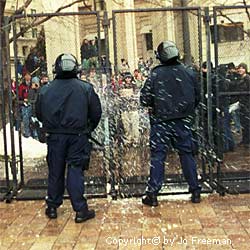 protestors faced police on the opposite side. One burned an American flag. Others threw snowballs at the fence, which splattered onto the police, forcing them to move ten feet back. protestors faced police on the opposite side. One burned an American flag. Others threw snowballs at the fence, which splattered onto the police, forcing them to move ten feet back.
The parade was supposed to start at 2:30, but after the official ceremonies Bush spent an extra hour at lunch, keeping protestors, paraders, and Republicans standing in the cold. The limousine carrying the President sped up at the ANSWER bleachers and every time it came to a cluster of anti-BUSH signs, forcing the accompanying phalanx of Secret Service officers into a run to keep up. Those who had waited for hours to cheer or jeer only had a few seconds to see a black car whiz by. When his car reached the corner of 15th St. where Pennsylvania Ave. becomes a pedestrian mall the President and his wife got out and walked, waving to the friendly crowd and smiling for the cameras. They watched the parade from glassed-in and heated bleachers erected in front of the White House.
Far fewer protestors than Republicans came to town and they spent less money. Official estimates put the cost of the inauguration to the taxpayers at 40 million dollars, about half from the D.C. budget. DAWN estimated that the protests cost about $20,000. Neither figure includes the travel costs of individuals who came from out of town.
Photos of the 2005 Counter-Inaugural Protests
| |